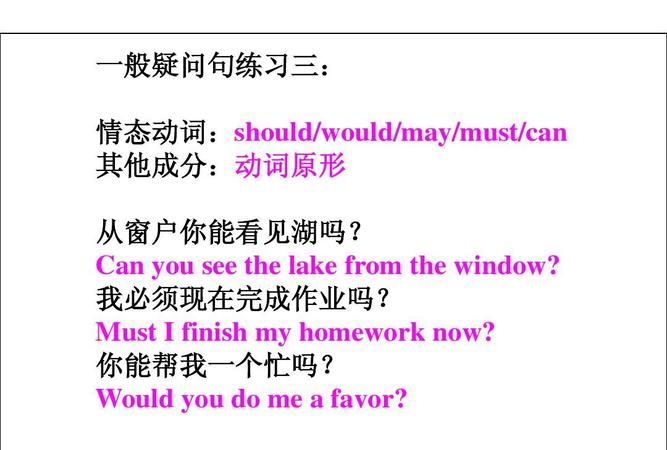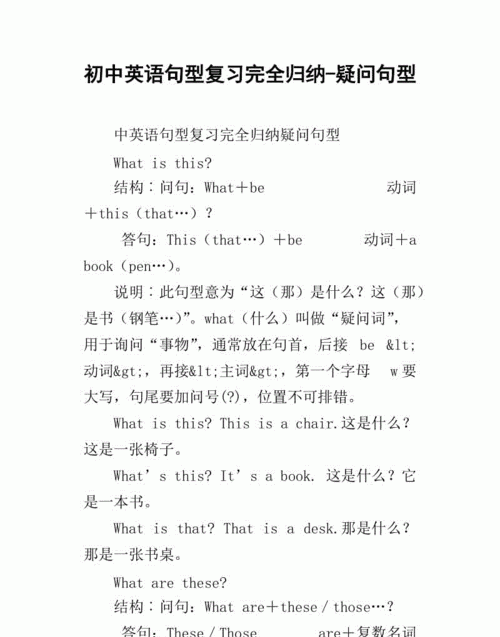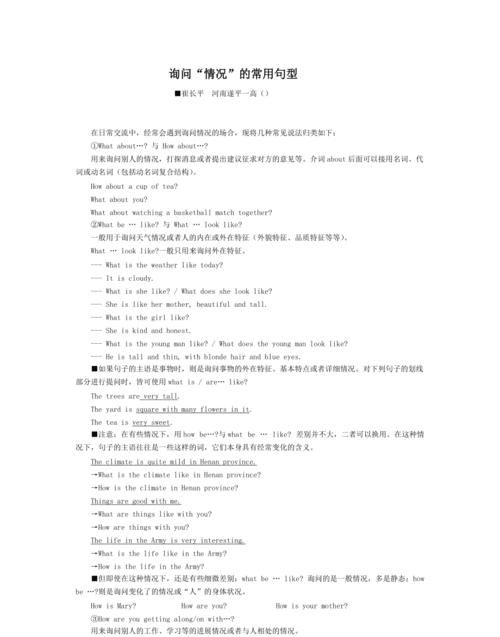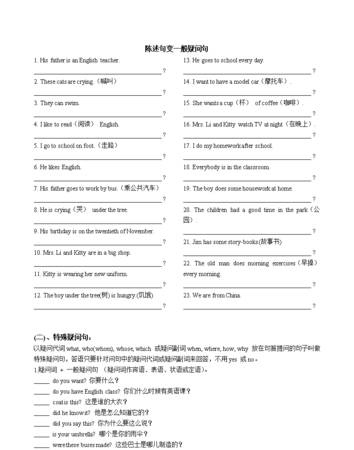本文目录
英语大神怎样学英语
这属于最最基本的英语疑问句和特殊疑问句得句型。一两句话谁都说不清楚。建议米找你得英语考试给你一边讲一边练说。当面讲很容易接受的。活着找个英语成绩好的同学给你讲,很简单,一般英语好一点的学生都会讲得清楚的!

英语6种基本句型
1.S(主) + Vi(不及物动词)(谓)
Time flies.
1) S + V + adverbial(状语)
Birds sing beautifully.
2) S + Vi+ prep Phrase(介词短语)
He went on holiday.
3) S + Vi+ Infinitive (不定式)
We stopped to have a rest.
4) S + Vi+ Participle (分词)
I'll go swimming.
2. S (主)+ Vt (及物动词)(谓)+ O(宾)
We like English.
1) S + VT + N/Pron
I like music.
I like her.
2) S + VT + infinitive(不定式)
I want to help him.
常用于这句型的动词有:attempt, dare, decide, desire, expect, hope, intend, learn, need, offer, pretend, promise, propose, purpose, refuse, want, wish等。
3) S + VT + Wh-Word + Infinitive
I don't know what to do.
常用于这句型的动词有:ask, consider, decide, discover, explain, find out, forget, guess, inquire, know, learn, observe, remember, see, settle, tell, think, understand, wonder等。
4) S + VT + Gerund
I enjoy living here.
常用于这句型的动词有:admit, advise, avoid, consider, defend, enjoy, excuse, finish, forbid, mind, miss, practise, risk, suggest, give up, can't help等。
5) S + VT + That-clause
I don't think (that) he is right.
常用于这句型的动词有:Admit, believe, command, confess, declare, demand, deny, doubt, expect, explain, feel(觉得), hear(听说), hope, imagine, intend, know, mean, mind(当心), notice, propose, request, report, say, see(看出),show, suggest, suppose, think, understand, wish, wonder(觉得奇怪)。
3. S (主)+ V(谓)(lv)( 系动词)+ P(表)
We are Chinese.
除了be 系动词外,还有一些动词也可以用作系动词,1)表感官的动词,feel, smell, taste, sound, look, appear, seem 等。2) 表转变变化的动词,become, get, grow, turn, go,等。 3)表延续的动词 remain, keep, seem, hold, stay, rest等。4)表瞬时的动词 come, fall, set, cut, occur等 5)其他动词 eat, lie, prove, ring, run, shine, sit, stand, continue, hang等。
1) S + Lv + N/Pron(名词/代词)
He is a boy.
This is mine.
2) S + Lv + Adj(形容词)
She is beautiful.
3) S + Lv + Adv (副词)
Class is over.
4) S + Lv + Prep Phrase
He is in good health.
5) S + Lv + Participle(分词)
He is excited.
The film is interesting.
4. S (主)+ VT (谓)+ In O(间接 宾) + D O(直接 宾)
I give you help.
1) S + VT + N/Pron + N
I sent him a book.
I bought May a book.
2) S + VT + N/Pron + To/for-phrase
He sent a book to me.
He bought a coat for me.
间接宾语前需要加to 的常用动词有:allow, bring, deny, do(带来), give, grant, hand, leave, lend, offer, owe, pass, pay, permit, promise, read, refuse, render, restore, sell, send, show, teach, tell wish, write等。
间接宾语前需要加for 的常用动词有:bring, buy, cash, choose, fetch, get, leave, make, order, paint, play(演奏),save, sing, spare等。
5. S (主)+ VT(谓)+ O(宾) + O C(宾补)
I make you clear.
1) S + VT + N/Pron + N
We named our baby Tom.
常用于这句型的动词有:appoint, call, choose, elect, entitle, find, make, name, nominate(命名)。
2) S + VT + N/Pron + Adj
He painted the wall white.
常用于这句型的动词有:beat, boil, cut, drive, find, get, hold, keep, leave, like, make, paint, see, set, turn, want, wash, wipe, wish等。
3) S + VT + N/Pron + Prep Phrase
She always keeps everything in good order.
4) S + VT + N/Pron + Infinitive
I wish you to stay.
I made him work
常用于这句型的动词有:a)不定式带to的词:advice, allow, ask, beg, cause, choose, command, decide, encourage, expect, force, get, hate, invite, know, leave, like, love, order, permit, persuade, prefer, remain, request, teach, tell, want, warn, wish等。b)不定式不带to的词:feel, have, hear, know, let, listen to, look at, make, notice, see, watch等。
5) S + VT + N/Pron + Participle (分词)
I heard my name called.
I feel something moving.
常用于这句型的动词有:catch, feel, find, get, have, hear, imagine, keep, leave, listen to, look at, notice, observe, perceive, see, set, smell, start, watch等。
6) S + VT + N/Pron + Wh-word + Infinitive
He show me how to do it.
常用于这句型的动词有:advise, ask, inform, show, teach, tell等。
7) S + VT + N/Pron + That-clause
He told me that the film was great.
常用于这句型的动词有:assure, inform, promise, remind, teach, tell, warm等。
8) S + VT + N/Pron + Wh-Clause
He asked me what he should do.
常用于这句型的动词有:Advise, ask, inform, show, teach, tell.

广东高考英语口语题型
疑问句型:
1) 一般疑问句
Is he a doctor?
Do you the way to the station?
2)反意疑问句
He is a teacher, isn’t he?
It is quite cheap, don’t you think?
3) 特殊疑问句
What is the distance/width/size/population/temperature/fare?
Who is he?
What is he?(干什么的)
What is he like?
How is he?
How do you like him?
What do you think of him?
What ever do you mean by saying this?
4)选择疑问句
He is a doctor or a nurse?
5)间接疑问句
Do you know how old he is?
Tell me if (whether) you like it.
What do you think/say/suppose I should do?

江苏初一学哪些科目英语
【句型】
一、 How do you like ... ?
〔句型介绍〕 用来询问对某人 / 物喜欢到什么程度,意为\"你觉得......怎么样\",常以I like ... a lot / a great deal / very much. 回答。
-How do you like your hometown? 你觉得你家乡怎么样?
-I like it very much. 我很喜欢。
〔句式比较〕 What do you think of ... ?= How do you think about ... ?= How do you find / enjoy ... ?不知道对方是否喜欢某人 / 物而加以询问,回答时应对此人 / 物作出评价。
-What do you think of / How do you think about the book? 你认为这本书怎么样?
-Very interesting. 很有趣。
-How do you find / enjoy this show ? 你认为这个节目怎么样?
-Dull. 枯燥。 ( find 找到,寻得;发现;碰上)
〔特别提醒〕 注意这些句式的不同含义。
二、 What do you have for ... ?
〔句型介绍〕 用来询问某人一日三餐吃什么, for后面应接一日三餐名词。
-What do you have for lunch? 你中午吃什么?
-I usually have rice. 我通常吃米饭。
〔句式比较〕 What do you eat for ... ?与What do you have for ... ?用法相同。
-What do you eat for your supper? 晚饭你吃什么?
-Noodles. 面条。
〔特别提醒〕 因句中have为实义动词,所以该句型不能改为What have you for ...?
三、What do you do ... ?
〔句型介绍〕 该句询问对方职业,意为\"你是干什么的?\",人称可随语境而变化,第一个do为助动词,单复数随主语的变化而变化,第二个do为实义动词。
-What do you do? 你是干什么的?
-I'm a worker. 我是一个工人。
〔句式比较〕 What are you? 你是干什么的?what表职业, be动词单复数随主语的变化而变化。
What is he? 他是干什么的?
-He is a student. 他是一个学生。
〔特别提醒〕 注意what的不同含义。
四、 How do you go to ... ?
〔句型介绍〕 该句为询问对方交通方式的用语,常用by, in, on接交通工具的名词作回答。
-How do you go to school? 你怎么去上学?
-By bus. 乘公共汽车。
〔句式比较〕 How do you come to ... ?的用法与How do you go to ...?句型相似。
-How do you come to our school? 你怎么来到我们学校的?
-In a taxi. 打的来的。
〔特别提醒〕 回答这两个句型时, by后面应接交通工具名词原形,而in, on后面根据需要可用不定冠词或数词修饰交通工具名词。
五、 What's your favourite ... ?
〔句型介绍〕 该句用来询问对方最喜欢什么,相当于What ... do you like best?
-What\'s your favourite subject? 你最喜欢什么学科?
-English. 英语。
-What colour do you like best? 你最喜欢什么颜色? (best 最好的) (good和well的最高级)
-Red. 红色。
〔句式比较〕 Which ... do you like best? 你最喜欢哪一个......?
-Which book do you like best? 你最喜欢哪一本书?
-This one. 这一本。
〔特别提醒〕关注这些句型含义和结构的微小区别。
六、 What's wrong with ... ?
〔句型介绍〕 该句询问某人或某物有何毛病,意为\"......怎么啦?\" wrong为形容词,前面不加定冠词。
What's wrong with you? You don\'t look well. 你怎么啦?脸色看起来不好。
〔句式比较〕 What's the matter / trouble with ... ?含义和用法与What's wrong with ... ?相同, matter和trouble为名词,前面应加定冠词。
-What's the trouble / matter with your bike? 你的自行车怎么啦?
-It can't run fast. 它走不快。
〔特别提醒〕 注意这些句型中连系动词后面有无冠词。
1.(1)be后的动词常用ing形式;(2)介词后面常用ing形式,如:be worried about doing sth.,be excited about doing sth.,be good/bad at doing sth.,be interested in doing sth.等;另外,有些动词后面的动词一定要用ing形式,如:enjoy,finish,practise,miss等。
2.一部分动词后面要搭配to do结构,如:ask sb.to do sth.,tell sb.to do sth.等;另外,to do还能表目的,如:She gives me a book to read.
3.(1)助动词后常用原形(现在完成时和过去完成时除外),如:He didn't call me./We won't go there by car.(2)祈使句中用动词原形,如:Open the door, please./Don't feed the animals.
助动词be, have, do, shall, will, should, would
1.S(主) + Vi(不及物动词)(谓)
Time flies.
1) S + V + adverbial(状语)
Birds sing beautifully.
2) S + Vi+ prep Phrase(介词短语)
He went on holiday.
3) S + Vi+ Infinitive (不定式)
We stopped to have a rest.
4) S + Vi+ Participle (分词)
I'll go swimming.
2. S (主)+ Vt (及物动词)(谓)+ O(宾)
We like English.
1) S + VT + N/Pron
I like music.
I like her.
2) S + VT + infinitive(不定式)
I want to help him.
常用于这句型的动词有:attempt, dare, decide, desire, expect, hope, intend, learn, need, offer, pretend, promise, propose, purpose, refuse, want, wish等。
3) S + VT + Wh-Word + Infinitive
I don't know what to do.
常用于这句型的动词有:ask, consider, decide, discover, explain, find out, forget, guess, inquire, know, learn, observe, remember, see, settle, tell, think, understand, wonder等。
4) S + VT + Gerund
I enjoy living here.
常用于这句型的动词有:admit, advise, avoid, consider, defend, enjoy, excuse, finish, forbid, mind, miss, practise, risk, suggest, give up, can't help等。
5) S + VT + That-clause
I don't think (that) he is right.
常用于这句型的动词有:Admit, believe, command, confess, declare, demand, deny, doubt, expect, explain, feel(觉得), hear(听说), hope, imagine, intend, know, mean, mind(当心), notice, propose, request, report, say, see(看出),show, suggest, suppose, think, understand, wish, wonder(觉得奇怪)。
3. S (主)+ V(谓)(lv)( 系动词)+ P(表)
We are Chinese.
除了be 系动词外,还有一些动词也可以用作系动词,1)表感官的动词,feel, smell, taste, sound, look, appear, seem 等。2) 表转变变化的动词,become, get, grow, turn, go,等。 3)表延续的动词 remain, keep, seem, hold, stay, rest等。4)表瞬时的动词 come, fall, set, cut, occur等 5)其他动词 eat, lie, prove, ring, run, shine, sit, stand, continue, hang等。
1) S + Lv + N/Pron(名词/代词)
He is a boy.
This is mine.
2) S + Lv + Adj(形容词)
She is beautiful.
3) S + Lv + Adv (副词)
Class is over.
4) S + Lv + Prep Phrase
He is in good health.
5) S + Lv + Participle(分词)
He is excited.
The film is interesting.
4. S (主)+ VT (谓)+ In O(间接 宾) + D O(直接 宾)
I give you help.
1) S + VT + N/Pron + N
I sent him a book.
I bought May a book.
2) S + VT + N/Pron + To/for-phrase
He sent a book to me.
He bought a coat for me.
间接宾语前需要加to 的常用动词有:allow, bring, deny, do(带来), give, grant, hand, leave, lend, offer, owe, pass, pay, permit, promise, read, refuse, render, restore, sell, send, show, teach, tell wish, write等。
间接宾语前需要加for 的常用动词有:bring, buy, cash, choose, fetch, get, leave, make, order, paint, play(演奏),save, sing, spare等。
5. S (主)+ VT(谓)+ O(宾) + O C(宾补)
I make you clear.
1) S + VT + N/Pron + N
We named our baby Tom.
常用于这句型的动词有:appoint, call, choose, elect, entitle, find, make, name, nominate(命名)。
2) S + VT + N/Pron + Adj
He painted the wall white.
常用于这句型的动词有:beat, boil, cut, drive, find, get, hold, keep, leave, like, make, paint, see, set, turn, want, wash, wipe, wish等。
3) S + VT + N/Pron + Prep Phrase
She always keeps everything in good order.
4) S + VT + N/Pron + Infinitive
I wish you to stay.
I made him work
常用于这句型的动词有:a)不定式带to的词:advice, allow, ask, beg, cause, choose, command, decide, encourage, expect, force, get, hate, invite, know, leave, like, love, order, permit, persuade, prefer, remain, request, teach, tell, want, warn, wish等。b)不定式不带to的词:feel, have, hear, know, let, listen to, look at, make, notice, see, watch等。
5) S + VT + N/Pron + Participle (分词)
I heard my name called.
I feel something moving.
常用于这句型的动词有:catch, feel, find, get, have, hear, imagine, keep, leave, listen to, look at, notice, observe, perceive, see, set, smell, start, watch等。
6) S + VT + N/Pron + Wh-word + Infinitive
He show me how to do it.
常用于这句型的动词有:advise, ask, inform, show, teach, tell等。
7) S + VT + N/Pron + That-clause
He told me that the film was great.
常用于这句型的动词有:assure, inform, promise, remind, teach, tell, warm等。
8) S + VT + N/Pron + Wh-Clause
He asked me what he should do.
常用于这句型的动词有:Advise, ask, inform, show, teach, tell.

以上就是关于听说提问常用句型 ,英语大神怎样学英语的全部内容,以及听说提问常用句型 的相关内容,希望能够帮到您。

